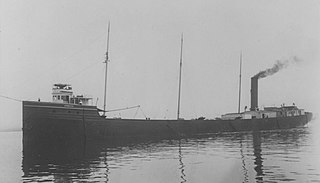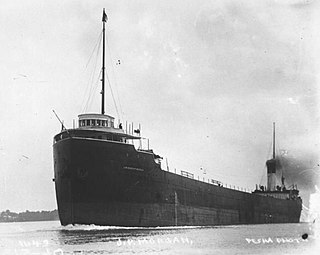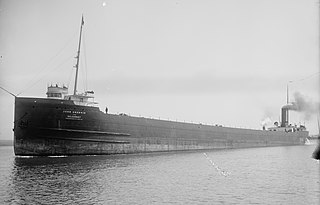Related Research Articles

Lake freighters, or lakers, are bulk carrier vessels that ply the Great Lakes of North America. These vessels are traditionally called boats, although classified as ships.

The SS Appomattox was a wooden-hulled, American Great Lakes freighter that ran aground on Lake Michigan, off Atwater Beach off the coast of Shorewood, Wisconsin in Milwaukee County, Wisconsin, United States in 1905. On the day of January 20, 2005 the remnants of the Appomattox were listed on the National Register of Historic Places.
Seven merchant ships have been named SS Samuel Mather.
Two merchant ships have been named SS John B. Cowle.
Six merchant ships and one U.S. Navy tug have been named Sagamore.
Queen of the Lakes is the unofficial but widely recognized title given to the longest vessel active on the Great Lakes of the United States and Canada. A number of vessels, mostly lake freighters, have been known by the title.

The SS Western Reserve was a propeller lake freighter that was constructed in 1890 by the Cleveland Shipbuilding Company for Peter G. Minch, a ship's captain and operator who was pioneering the industrialization of bulk carrier freight service on the Great Lakes. She had a length of 301 feet, a beam of 41 feet and drew 21 feet of water. She and a ship of similar dimensions and building history, the SS W.H. Gilcher, were two of the first lake freighters to be constructed out of steel plate. Her steel construction made it possible for the vessel to carry heavier loads of freight than her wooden rival steamships.

The SS Ira H. Owen was a Great Lakes freighter that sank near Outer Island in the Apostle Islands, Lake Superior, in the Mataafa Storm on November 28, 1905. She was loaded with 116,000 bushels of barley which was considered a "light load". The 19 crew of the Ira H. Owen's died in the vessel's sinking. The wreck of the Ira H. Owen has never been found, but some people claim she reappears as a ghost ship.

The J. Pierpont Morgan, named after legendary banking titan J. P. Morgan, was a 601-foot-long (183 m) American steel-hulled, propeller-driven Great Lakes freighter that was a product of the Chicago Shipbuilding Company of Chicago, Illinois. The Morgan hauled bulk cargoes such as iron ore, coal, grain and occasionally limestone across the Great Lakes of Canada and North America. She served her whole career without any major incidents. She was the first of three identical sister ships, these were the Henry H. Rogers and the Norman B. Ream.

The John Sherwin was an American steel-hulled, propeller-driven Great Lakes freighter built in 1906 by the West Bay City Shipbuilding Company of Bay City, Michigan for service on the Great Lakes of North America. She was used to transport bulk cargoes such as coal, iron ore and grain. She served from her launching in 1906 to her scrapping in 1974, in Germany.

SS D.R. Hanna was a 552-foot (168 m) long American Great Lakes freighter that operated on the Great Lakes from November 12, 1906 to her sinking on May 16, 1919 after a collision with Quincy A. Shaw. D.R. Hanna was like many other freighters, and was used to haul bulk cargoes such as iron ore, coal and grain.

SS Choctaw was an American semi-whaleback freighter in service between 1892 and 1915. She was a monitor vessel containing elements from both traditional lake freighters and the whaleback ships designed by Alexander McDougall. Choctaw was built in 1892 by the Cleveland Shipbuilding Company in Cleveland, Ohio. Originally owned by the Lake Superior Iron Company, she was sold to the Cleveland-Cliffs Iron Company in 1894, the firm for which she would spend the rest of her career working.

SS Robert Wallace was a wooden-hulled American bulk freighter that served on the Great Lakes of North America from her construction in 1882 to her sinking in 1902 on Lake Superior near the town of Palmers, St. Louis County, Minnesota, United States. On November 17, 1902 shortly after leaving Superior, Wisconsin with a cargo of iron ore, Robert Wallace sprang a leak and sank. Her wreck was found in 2006, and on October 14, 2009, the wreck of Robert Wallace was listed in the National Register of Historic Places.

SS Senator was a steel-hulled Great Lakes freighter that sank on Lake Michigan with the loss of nine lives and 268 Nash automobiles, on Halloween of 1929 after she was rammed in heavy fog by the bulk carrier Marquette. She lies in 450 feet (140 m) of water 16 miles northeast of Port Washington, Wisconsin. On April 12, 2016 her wreck was listed on the National Register of Historic Places.

SS Hudson was a steel-hulled package freighter that served on the Great Lakes from her construction in 1887 to her sinking in 1901. On September 16, 1901, while heading across Lake Superior with a cargo of wheat and flax, she ran into a storm and sank with the loss of all 25 crew off Eagle Harbor, Michigan. For nearly 118 years the location of Hudson's wreck remained unknown, until in July 2019 her wreck was found in 825 feet (251 m) of water, completely intact.

SS S.R. Kirby was a composite-hulled bulk carrier that served on the Great Lakes of North America from her construction in 1890 to her sinking in 1916. On May 8, 1916, while heading across Lake Superior with a cargo of iron ore and the steel barge George E. Hartnell in tow, she ran into a storm and sank with the loss of all but two of her 22-man crew off Eagle Harbor, Michigan. For over 102 years the location of S.R. Kirby's wreck remained unknown, until June 2018, when her wreck was discovered by the Great Lakes Shipwreck Historical Society (GLSHS) in 825 feet (251 m) of water, completely broken up.

SS Russia was an iron-hulled American Great Lakes package freighter that sank in a Lake Huron gale on April 30, 1909, near DeTour Village, Michigan, with all 22 of her crew and one passenger surviving.

SS Vernon was a wooden-hulled American passenger and package freighter that sank in a Lake Michigan storm on October 29, 1887 near Two Rivers, Wisconsin with the loss of between 36 and 50 lives, making her one of the deadliest shipwrecks ever to have occurred in Wisconsin. Only one of the people on board survived.

SS John V. Moran was a wooden-hulled American package freighter that sank without loss of life on Lake Michigan, near Muskegon, Michigan on February 12, 1899 after being holed by ice.

Robert C. Pringle, originally named Chequamegon, was a wooden-hulled American tugboat that sank without loss of life on Lake Michigan, near Sheboygan, Wisconsin on June 19, 1922 after striking an obstruction.
References
- ↑ "Sherwin, John 1". Bowling Green State University . Retrieved January 19, 2021.
- ↑ "Sherwin, John 2". Bowling Green State University . Retrieved January 19, 2021.
- ↑ "John Sherwin (2)". Boatnerd . Retrieved January 19, 2021.
| This article includes a list of ships with the same or similar names. If an internal link for a specific ship led you here, you may wish to change the link to point directly to the intended ship article, if one exists. |